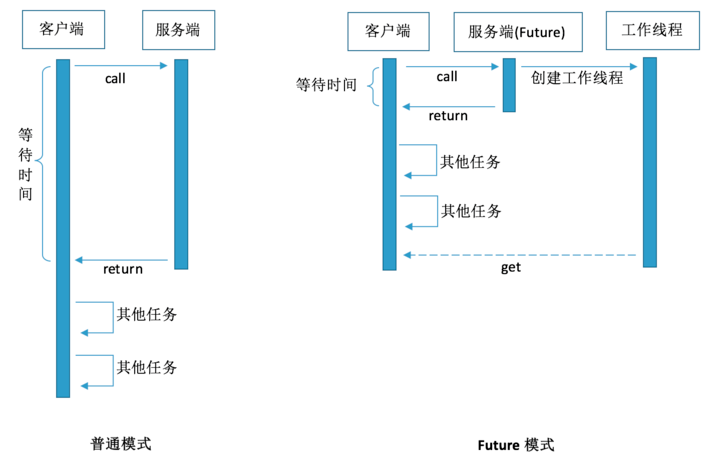一、Future模式
Java 1.5开始,提供了Callable和Future,通过它们可以在任务执行完毕之后得到任务执行结果。
Future接口可以构建异步应用,是多线程开发中常见的设计模式。
当我们需要调用一个函数方法时。如果这个函数执行很慢,那么我们就要进行等待。但有时候,我们可能并不急着要结果。
因此,我们可以让被调用者立即返回,让他在后台慢慢处理这个请求。对于调用者来说,则可以先处理一些其他任务,在真正需要数据的场合再去尝试获取需要的数据。

1、Callable与Runnable
java.lang.Runnable是一个接口,在它里面只声明了一个run()方法,run返回值是void,任务执行完毕后无法返回任何结果
public interface Runnable {
public abstract void run();
}
Callable位于java.util.concurrent包下,它也是一个接口,在它里面也只声明了一个方法叫做call(),这是一个泛型接口,call()函数返回的类型就是传递进来的V类型
public interface Callable<V> {
V call() throws Exception;
}
2、Future + Callable
Future就是对于具体的Runnable或者Callable任务的执行结果进行取消、查询是否完成、获取结果。必要时可以通过get方法获取执行结果,该方法会阻塞直到任务返回结果
public interface Future<V> {
boolean cancel(boolean mayInterruptIfRunning);
boolean isCancelled();
boolean isDone();
V get() throws InterruptedException, ExecutionException;
V get(long timeout, TimeUnit unit)
throws InterruptedException, ExecutionException, TimeoutException;
}
怎么使用Future和Callable呢?一般情况下是配合ExecutorService来使用的,在ExecutorService接口中声明了若干个submit方法的重载版本
<T> Future<T> submit(Callable<T> task);
<T> Future<T> submit(Runnable task, T result);
Future<?> submit(Runnable task);
Future+Callable,使用示例如下(采用第一个方法):
结果:
result:297483790
其它方式:
import java.util.Random;import java.util.concurrent.*;/** * @program: callable * @description: testfuture * @author: Mr.Wang * @create: 2018-08-12 12:11 **/public class Testfuture { public static void main(String[] args){ //第一种方式 FutureTask<Integer> task = new FutureTask<Integer>(new Callable<Integer>() { @Override public Integer call() throws Exception { return new Random().nextInt(); } }); new Thread(task).start(); //第二种方方式// ExecutorService executor = Executors.newSingleThreadExecutor();// FutureTask<Integer> task = new FutureTask<Integer>(new Callable<Integer>() {// @Override// public Integer call() throws Exception {// return new Random().nextInt();// }// });// executor.submit(task); try { System.out.println("result: "+task.get()); } catch (InterruptedException e) { e.printStackTrace(); } catch (ExecutionException e) { e.printStackTrace(); } }}
result:-358490809
3、Future 接口的局限性
了解了Future的使用,这里就要谈谈Future的局限性。Future很难直接表述多个Future 结果之间的依赖性,开发中,我们经常需要达成以下目的:
-
将两个异步计算合并为一个(这两个异步计算之间相互独立,同时第二个又依赖于第一个的结果)
-
等待 Future 集合中的所有任务都完成。
-
仅等待 Future 集合中最快结束的任务完成,并返回它的结果。
二、CompletableFuture
首先,CompletableFuture类实现了CompletionStage和Future接口,因此你可以像Future那样使用它。
莫急,下面通过例子来一步一步解释CompletableFuture的使用。
创建CompletableFuture对象
说明:Async结尾的方法都是可以异步执行的,如果指定了线程池,会在指定的线程池中执行,如果没有指定,默认会在ForkJoinPool.commonPool()中执行。下面很多方法都是类似的,不再做特别说明。
四个静态方法用来为一段异步执行的代码创建CompletableFuture对象,方法的参数类型都是函数式接口,所以可以使用lambda表达式实现异步任务
runAsync方法:它以Runnabel函数式接口类型为参数,所以CompletableFuture的计算结果为空。
supplyAsync方法以Supplier函数式接口类型为参数,CompletableFuture的计算结果类型为U。
public static CompletableFuture<Void> runAsync(Runnable runnable)
public static CompletableFuture<Void> runAsync(Runnable runnable, Executor executor)
public static <U> CompletableFuture<U> supplyAsync(Supplier<U> supplier)
public static <U> CompletableFuture<U> supplyAsync(Supplier<U> supplier, Executor executor)
1、变换结果
public <U> CompletionStage<U> thenApply(Function<? super T,? extends U> fn);
public <U> CompletionStage<U> thenApplyAsync(Function<? super T,? extends U> fn);
public <U> CompletionStage<U> thenApplyAsync(Function<? super T,? extends U> fn,Executor executor);
这些方法的输入是上一个阶段计算后的结果,返回值是经过转化后结果
例子:
import java.util.concurrent.CompletableFuture;
/**
* @program: callable
* @description: test
* @author: Mr.Wang
* @create: 2018-08-12 12:36
**/
public class TestCompleteFuture {
public static void main(String[] args){
String result = CompletableFuture.supplyAsync(()->{return "Hello ";}).thenApplyAsync(v -> v + "world").join();
System.out.println(result);
}
}
结果:
Hello world
2、消费结果
public CompletionStage<Void> thenAccept(Consumer<? super T> action);
public CompletionStage<Void> thenAcceptAsync(Consumer<? super T> action);
public CompletionStage<Void> thenAcceptAsync(Consumer<? super T> action,Executor executor);
这些方法只是针对结果进行消费,入参是Consumer,没有返回值
例子:
import java.util.concurrent.CompletableFuture;
/**
* @program: callable
* @description: test
* @author: Mr.Wang
* @create: 2018-08-12 12:36
**/
public class TestCompleteFuture {
public static void main(String[] args){
CompletableFuture.supplyAsync(()->{return "Hello ";}).thenAccept(v -> { System.out.println("consumer: " + v);});
}
}
结果:
consumer: Hello
3、结合两个CompletionStage的结果,进行转化后返回
public <U,V> CompletionStage<V> thenCombine(CompletionStage<? extends U> other,BiFunction<? super T,? super U,? extends V> fn);
public <U,V> CompletionStage<V> thenCombineAsync(CompletionStage<? extends U> other,BiFunction<? super T,? super U,? extends V> fn);
public <U,V> CompletionStage<V> thenCombineAsync(CompletionStage<? extends U> other,BiFunction<? super T,? super U,? extends V> fn,Executor executor);
需要上一阶段的返回值,并且other代表的CompletionStage也要返回值之后,把这两个返回值,进行转换后返回指定类型的值。
说明:同样,也存在对两个CompletionStage结果进行消耗的一组方法,例如thenAcceptBoth,这里不再进行示例。
例子:
import java.util.concurrent.CompletableFuture;
/**
* @program: callable
* @description: test
* @author: Mr.Wang
* @create: 2018-08-12 12:36
**/
public class TestCompleteFuture {
public static void main(String[] args){
String result = CompletableFuture.supplyAsync(()->{
try {
Thread.sleep(1000);
} catch (InterruptedException e) {
e.printStackTrace();
}
return "Hello";
}).thenCombine(CompletableFuture.supplyAsync(()->{
try {
Thread.sleep(2000);
} catch (InterruptedException e) {
e.printStackTrace();
}
return "world";
}),(s1,s2)->{return s1 + " " + s2;}).join();
System.out.println(result);
}
}
结果:
Hello world
4、两个CompletionStage,谁计算的快,就用那个CompletionStage的结果进行下一步的处理
public <U> CompletionStage<U> applyToEither(CompletionStage<? extends T> other,Function<? super T, U> fn);
public <U> CompletionStage<U> applyToEitherAsync(CompletionStage<? extends T> other,Function<? super T, U> fn);
public <U> CompletionStage<U> applyToEitherAsync(CompletionStage<? extends T> other,Function<? super T, U> fn,Executor executor);
两种渠道完成同一个事情,就可以调用这个方法,找一个最快的结果进行处理,最终有返回值。
例子:
import java.util.concurrent.CompletableFuture;
/**
* @program: callable
* @description: test
* @author: Mr.Wang
* @create: 2018-08-12 12:36
**/
public class TestCompleteFuture {
public static void main(String[] args){
String result = CompletableFuture.supplyAsync(()->{
try {
Thread.sleep(100);
} catch (InterruptedException e) {
e.printStackTrace();
}
return "Hi Boy";
}).applyToEither(CompletableFuture.supplyAsync(()->{
try {
Thread.sleep(300);
} catch (InterruptedException e) {
e.printStackTrace();
}
return "Hi Girl";
}),(s)->{return s;}).join();
System.out.println(result);
}
}
结果:
Hi Boy
5、运行时出现了异常,可以通过exceptionally进行补偿
public CompletionStage<T> exceptionally(Function<Throwable, ? extends T> fn);
例子:
import java.util.concurrent.CompletableFuture;
/**
* @program: callable
* @description: test
* @author: Mr.Wang
* @create: 2018-08-12 12:36
**/
public class TestCompleteFuture {
public static void main(String[] args){
String result = CompletableFuture.supplyAsync(()->{
try {
Thread.sleep(100);
} catch (InterruptedException e) {
e.printStackTrace();
}
if(true) {
throw new RuntimeException("exception test!");
}
return "Hi Boy";
}).exceptionally(e->{
System.out.println(e.getMessage());
return "Hello world!";
}).join();
System.out.println(result);
}
}
结果:
java.lang.RuntimeException: exception test!
Hello world!
三、结束
OK,了解了以上使用,基本上就对CompletableFuture比较清楚了。
后面会找个时间说说CompletableFuture实现原理
